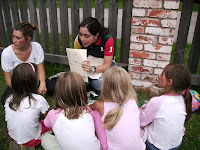
Izmēģināt savādāku vasaru. Atkārtot jau izdzīvotu pieredzi. Sekot draudzenes padomam. Izdarīt kaut ko priekš citiem... Šie un citi motīvi bija tie, kas saveda kopā vairāk nekā 20 latviešu un spāņu jaunietes, lai no 2008. gada 12. līdz 24. jūlijam piedalītos Rīvas Kultūras centra organizētā sociālā darba nometnē Aizputē. Nometnes mērķis bija veicināt sociālo sadarbību starp studentēm. Rakele Moreno, projekta koordinatore, intervijā skaidro šīs iniciatīvas rašanos un attīstību.
Kā radās šī sociālā darba nometne?
Iniciatīva radās 2006. gada sākumā. Rīvas Kultūras centrs meklēja kādu vietu Latvijā, kur jaunās studentes, latvietes un spānietes, varētu nesavtīgi palīdzēt un ieguldīt daļu no sava brīvā laika vasarā. Projekts meitenēm dotu iespēju palīdzēt uzņemties rūpes par garīgajām un materiālajām vajadzībām, kas pastāv dažos Latvijas reģionos. Mērķis nebija tikai apzināt vajadzības, bet gan saprast, ka viņas var piedalīties to atrisināšanā. Mēs vērsāmies pie vienīgās Aizputes katoļu draudzes priestera, kas ļoti atvērti attiecās pret projektu jau no paša sākuma un atviegloja darba organizāciju. Tā mēs jau trīs gadus realizējam šo darba nometni Aizputē.
Kādas konkrētas vajadzības jūs palīdzējāt atvieglot Aizputē?
Pilsētai ir aptuveni 3 000 iedzīvotāju un liela reliģisko konfesiju dažādība: luterāņu, baptisti, adventisti, pareizticīgie un katoļi. Katoļi tur ir gluži kā minoritāte. Šī bija pirmā vajadzība – palīdzēt Katoļu baznīcai Latvijā. Darbi pašreizējā draudzē ir paralizēti kopš 2002. gada ekonomisko apstākļu dēļ. 2007. gadā no kādas Berlīnes baznīcas tika atsūtīti soli, svečturi, altāris un tabernākuls. Iespējams, ka 2009. gadā baznīca tiks atvērta dievkalpojumiem.
Priesteris mums arī ieteica sadarboties ar Rokaižu pansionātu, kas pieder pilsētas pašvaldībai. Tas atrodas 3 km no Aizputes, netālu no nometnes. Pansionātam pieder govis, sakņu dārzs, kartupeļu lauks, kas dod neatkarību sirmgalvju mājvietai. Tur šobrīd mitinās 150 cilvēku. Pēdējos mēnešos pansionātā ir ienākuši cilvēki vecumā starp 40 – 50 gadiem, ar alkoholisma problēmām. Personālam šī ir ļoti nopietna problēma, jo šo slimnieku vajadzības atšķiras no sirmgalvju vajadzībām, un ir grūti tikt ar tām galā. Vecie ļaudis ir izvietoti divās ēkās; viena ir jauna, atklāta 2006. gadā, bet otras stāvoklis ļoti slikts. Šai institūcijai ir ļoti mazs personāls, lai varētu veikt tādu darbu. Brīvprātīgo piedalīšanās pansionāta darbā vasarā sastāvēja no sirmgalvju pavadīšanas, kuri šeit jūtas ļoti vientuļi, kā arī materiālās sadarbības pansionātā.
Jūs minējāt, ka Rīvas Kultūras centrs ir šīs nometnes rīkotājs, bet kas ir šis Kultūras centrs?
„Rīva” ir 2004. gadā izveidots kultūras un izglītības centrs, kas atrodas Rīgā. Ar dažādām kultūras un izglītības aktivitātēm „Rīva” gan jaunām, gan pieaugušām sievietēm sniedz nopietnu, pamatīgu kristīgo un laicīgo apmācību, tā palīdzot viņām attīstīt savu personību, kā arī dot savu ieguldījumu Latvijas sabiedrības labā ar savu darbu un dzīvi. Nodarbībās var uzzināt ko vairāk par bērnu audzināšanu, saskarsmi ģimenē, mājturību utt. Jaunietēm tiek organizēti pasākumi atkarībā no viņu vecuma, piemēram, rokdarbi, kulinārijas kursi un teātris, mācīšanas paņēmienu kursi, konferenču cikli par profesionālām un aktuālām tēmā, nometnes, utt. Viena no tām ir brīvprātīgā darba nometne Aizputē skolniecēm un studentēm.
Kas piedalās Jūsu projektā?
Latvijas un Spānijas universitāšu studentes, kas piedalās Rīvas Kultūras centra (Rīga), Universitātes rezidences „Alcor” (Colegio Mayor “Alcor”) un Universitātes centra „Vega” (Centro Universitario “Vega”) – abas pēdējās Madridē – aktivitātēs. Meitenes apgūst dažādus studiju virzienus: žurnālistiku, arhitektūru, bioloģiju, ekonomiku...
Lielākā daļa latviešu brīvdienas pavada laukos vai ceļojot. Vai esat spējušas motivēt latviešu meitenes?
Tas bija dabiski, ka vairāk meiteņu bija no Spānijas, jo divas projektā iesaistītās dalībinstitūcijas bija spāņu. Ārzemniecēm bija daudz interesantāk ceļot uz nepazīstamu valsti, arī ekskursijas no darba brīvajā laikā utt. Turklāt Spānijā ir tradīcija piedalīties brīvprātīgā darba aktivitātēs. Latviešu studentēm apstākļi ir savādāki. Šeit diemžēl nav tādas pieredzes brīvo laiku veltīt brīvprātīgajam darbam. Gandrīz piecdesmit gadus Latvija piedzīvoja komunistu diktatūru, kur vienīgais un galvenais aktieris bija valsts, nevis ikviens cilvēks. Šobrīd veidojas sabiedriskā apziņa, un cilvēki sāk saprast sava darba nozīmīgumu sabiedrības attīstīšanā. Tāpēc katras latviešu meitenes dalība projektā ir ļoti nozīmīga: viņas ir dziļas sabiedriskās atjaunošanās sēkliņas, kristīgās vēsts iedvesmotas.
Vai Jūs uzskatāt, ka darba nometnes mērķi ir izpildīti?
Materiālais darbs baznīcā un uzmanība sirmgalvjiem nav beigusies. Taču darba nometnes lielākais mērķis bija palīdzēt meitenēm saprast vajadzības, kas ir viņu apkārtnē. Katrs pilsonis, kaut arī tas būtu students, ar maz naudu vai zemām sabiedriskās ietekmēšanas iespējām, var kaut ko darīt. Tas nav tikai valdības pienākums risināt sociālās problēmas: pilsoņu brīvprātīga iniciatīva daudz nozīmē un nekad nav anulējama, ja gribam, lai sabiedrība būtu patiesi cilvēcīga un kristīga. To, ko tu vari darīt, bet nedari, neviens neizdarīs tavā vietā. Visi vēlas, lai Latvijā būtu mazāka sociālā nevienlīdzība, lai pensijas būtu labākas, lai būtu mazāk korupcijas utt. Labs veids ir izglītot jauniešus cilvēcīgo vērtību jomā: sociālajā atbildībā, patiesumā, lojalitātē, devīgumā, strādīgumā, rūpēs par citiem utt. Jaunieši ir nākotne, un mēs gaidām, ka meitenes, kas piedalījās šajā nometnē, būs kā laba sēkliņa nākotnes Latvijai.



.JPG)





